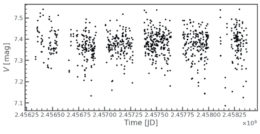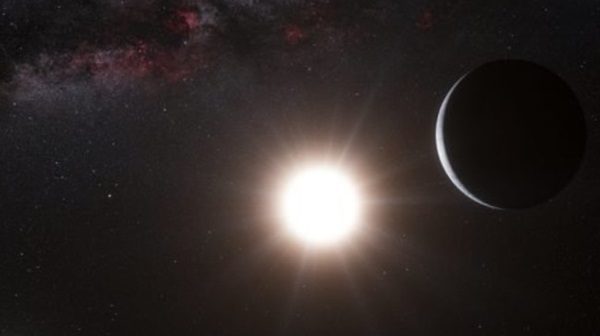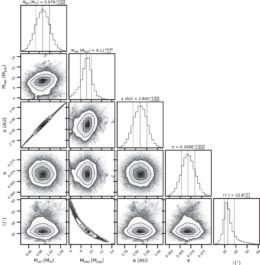How did the 14 Herculis planetary system get into an unusual configuration? Did the system have a run-in with another star, or was there a troublemaker within the system itself? Astronomers peek deep into the characteristics of the system to find out!
Planets Going the Distance

Light curve for 14 Herculis, as measured in the ASAS-SN (All-Sky Automated Survey for Supernovae) program. [Adapted from Bardalez Gagliuffi et al. 2021]
When the Planets Don’t Align
14 Her was one of the first stars targeted in radial-velocity searches for exoplanets because of its proximity and brightness. Astronomers detected the closer in of its two known planets, 14 Her b, in 2003, and its outer planet, 14 Her c, four years later. Using archival radial-velocity data from the high-resolution echelle spectrometer on the Keck Telescope and proper motions inferred from the Hipparcos–Gaia Catalog of Accelerations, the team was able to calculate the orbital parameters of the two planets.They found that planet b orbits at a semimajor axis of ~3 au and has a moderate eccentricity, and that planet c is 27 au from the star and has a highly eccentric orbit. Because the authors only had data for ~15% of 14 Her c’s orbit, they were only able to get a broad distribution of inclinations relative to 14 Her b, but the data pointed to the two orbits being misaligned by nearly 70 degrees. There are only three other known systems with giant planets that have misaligned orbits.
Feeling Inclined to Search for Answers
What caused this strange misalignment? The answer surely lies in the system’s dynamic past, but what kind of dynamic past is still up in the air. The most likely explanation is planet–planet scattering: multiple planets of similar mass formed together in circular orbits and gravitationally influenced one another, eventually leading to the ejection of one planet and affecting the orbits of the others. It’s also possible that a passing star came close enough to the system that it perturbed the orbits and launched one planet out of the system; to reach a stable configuration, the surviving planets got farther apart, and their eccentricities grew.
Imaging the system in the mid-infrared could reveal a hidden planetary sibling that might shed further light on 14 Her’s dynamic past, so we’ll just have to wait for JWST and the Nancy Grace Roman Space Telescope to help solve this mystery!
Citation
“14 Her: A Likely Case of Planet–Planet Scattering,” Daniella C. Bardalez Gagliuffi et al 2021 ApJL 922 L43. doi: 10.3847/2041-8213/ac382c



